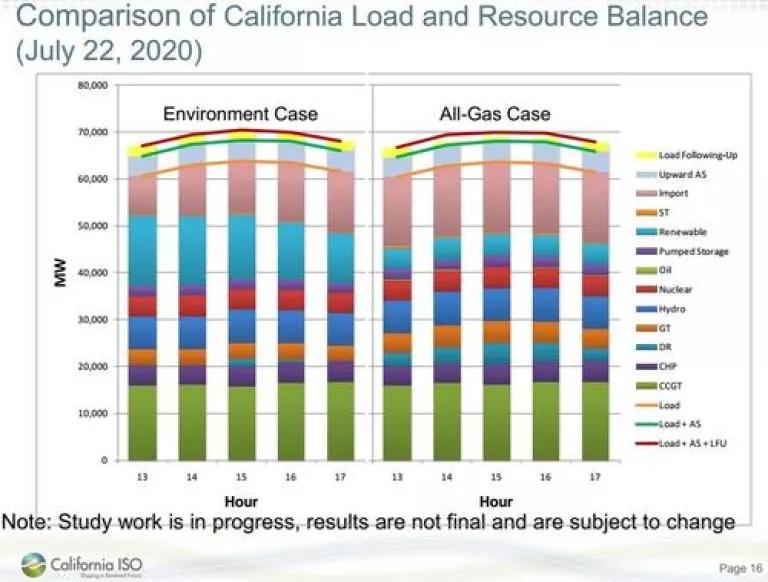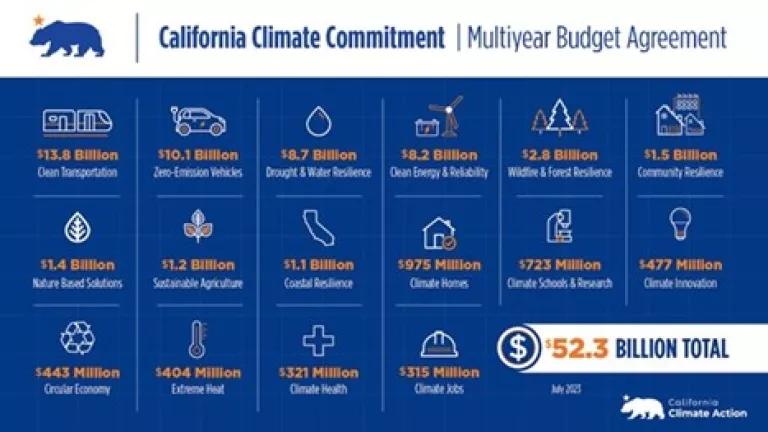At an extremely rare joint meeting this week, the entire membership of the California Public Utilities Commission (CPUC), California Energy Commission (CEC) and California Independent System Operator (CAISO) explored ways to make the state’s electricity grid operate more smoothly as new resources come into the system and displace older, dirtier and less-efficient types of fuel.
Unfortunately, the Wall Street Journal’s report from this important meeting didn’t capture the content and the intention of the session. California isn’t facing an imminent energy crisis, nor would renewables be to blame if such a thing occurred. What California is really facing is the need to add flexible capacity to its energy supply mix.
It’s important to understand that flexible capacity (which is not synonymous with simply building more gas generation) would be needed even if no new renewables were added to the grid. In the chart below, almost identical amounts of flexible capacity are needed in both high renewable and the no new renewable study cases run by CAISO. There would be a crisis only if the state did nothing to add flexibility to the system, and in fact California is doing plenty to address this need.
All Energy is Variable

Renewable energy is a variable energy source, but all energy sources are variable. For example, nuclear plants shut down for refueling, accidents or unexpected reasons, as the 2200 megawatts (enough electricity to supply approximately 1.1 million homes) San Onofre Nuclear Generating Station near San Diego did.
Unpredictable outages at fossil plants are common, and can be much more difficult to deal with than the variability of wind or solar. In many respects renewables are more reliable than conventional generation units. The variability of renewable resources is predictable. Because it is tied to weather conditions, you can literally see it coming, while unexpected outages at conventional generation plants can create unpleasant surprises for grid operators. Flexible capacity deals with both issues. Need for flexible capacity can be forecast and planned for renewables, or injected quickly to deal with forced outages or changes in load.
Other flexibility measures that facilitate the use of renewables, such as shorter scheduling intervals for adding resources to the grid and taking advantage of geographic diversity of resources – both within California and across the West – are also being adopted, as is the utilization of energy storage. The wind is always blowing somewhere, and the sun is almost never blocked by clouds everywhere across the sunny Southwest at the same time. In addition, the sun rises and sets at different times between states like California, Nevada and Arizona, aiding the ability of grid operators to handle big swings of generation and demand at the beginning and end of the day if they share access to resources. Technology and regional diversity of renewable projects provides flexibility without new fossil generation (coal is nearly useless for flexibility and gas, while more flexible, is not always needed). Clean Geothermal energy can replace dirty baseload power on a megawatt by megawatt basis.
To take advantage of the benefits of renewables, we must improve coordination between the entities that control parts of the grid (called Balancing Area Authorities), provide markets to help them share resources, exploit geographic diversity, and adopt compatible operating strategies. This might require automation technology and software upgrades, but these will eventually be needed anyway.
Benefits of a Flexible Grid
A more flexible grid also provides enormous cost savings because utilities and control areas can share reserve resources and avoid having to build duplicative infrastructure – getting more out of existing power plants and transmission lines. For example: the savings from simply moving to shorter scheduling for injecting resources into the grid (10 minutes rather than an hour) has been estimated at a whopping $1 billion annually by the Western Electricity Coordinating Council.
Momentum is steadily building on the emergence of a more flexible grid. The California Independent System Operator (CAISO) recently entered into an agreement to create an “energy imbalance market” with one of the West’s biggest utilities, PacifiCorp, that will allow for CAISO to add flexibility to its system by taking advantage of geographically diverse generation in five other states. The market players share reserves, reduce transmission congestion costs and more fully utilize underused transmission line capacity by providing electricity needed to meet shortfalls in one another’s systems, often for brief periods. This saves a lot of money and takes full advantage of the benefits of renewable generation.
Flexibility Leads to Reliability
Meanwhile, new grid control technologies, methods and communications are being implemented to ensure the system’s reliability. These provide real time data and “situational awareness” to grid operators who can then dispatch power from an array of sources to meet system needs across wider areas of the West. This enhances reliability as well as our ability to add ever-larger amounts of renewable power to the system. This means more flexibility, not less.
The grid of the future will be a more flexible grid. The old paradigm, where dirty and inflexible resources like coal, baseload natural gas and nuclear plants dominate and are transmitted on a “dumb” grid, is over.
California is pioneering ways to accelerate the establishment of a smarter, cleaner and more flexible grid, which is not an indicator of an impending crisis but rather a bellwether that a better, more cost-effective and reliable grid is on the way.



